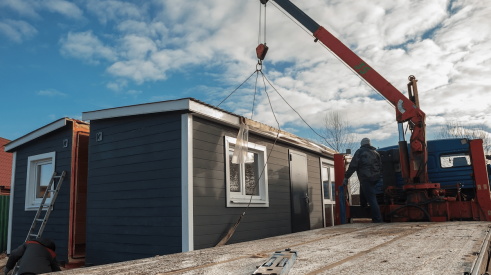1. When Does SB800 Apply?
SB800, effective Jan. 1, 2003, establishes a mandatory process prior to the filing of certain types of construction defect suits. The bill applies whenever there are defects alleged by a homeowner in new residential construction, but does not apply to condominium conversions.
2. Who is Covered by the Bill?
The bill provides that any construction defect action against a builder, subcontractor, product manufacturer or design professional will be governed by the standards set forth in SB800. (Note that the existing Certificate of Merit requirements for design professionals are not abrogated by the bill and apply in the event a lawsuit is filed after completion of the SB800 process.)
3. What is a "Defect" Under SB800?
The bill attempts to specifically define what constitutes a "defect" for virtually all aspects of a residential building and its appurtenant systems. Most of the definitions for defective construction concentrate on water intrusion issues (requiring that building systems such as windows, doors, roofs and plumbing "shall not leak") and also provide that the defects "shall not materially impair the use of the structure by its inhabitants."
4. What Must Be Done Before a Lawsuit is Filed?
The statutory process outlined by must be exhausted prior to the filing of a lawsuit. A Homeowner initiates the process by first submitting a written claim to Builder's designated agent. If no offer to repair the alleged defects is made by the Builder, or if the Builder otherwise fails to adhere strictly to the process, the Homeowner may proceed with the filing of a lawsuit.
5. What is the Timetable for the Claims Procedure?
As illustrated in the accompanying time-line (as well as in Attachment #2) the following hypothetical schedule assumes that a Homeowner has notified the Builder of alleged defects on January 3, 2003. It is also assumed (for purposes of simplicity and to illustrate the maximum duration of the statutory pre-litigation process), that each event takes place on the last day of the period allowed under the bill.
- Homeowner submits claim to Builder on January 3, 2003.
- Builder must "acknowledge" claim by January 17, 2003.
- If Builder sends Homeowner a written acknowledgment on January 17, it then has until January 31, 2003 to complete its preliminary inspection.
- Builder has until February 3, 2003 to request a second inspection. This second inspection must be completed within 40 days, i.e., by March 15, 2003.
- Builder then has until April 14, 2003 to make its offer to repair some, all or none of the alleged defects and to suggest a contractor to perform the work.
- Homeowner may consider Builder's offer until May 14, 2003.
- Should Homeowner object to the repair contractor designated by Builder, Builder has until June 18, 2003 to provide Homeowner with a list of three alternative contractors. [Builder may also make a final, "non-invasive" inspection, ostensibly to facilitate the involvement of the repair contractor, by June 3, 2003.]
- Assuming Homeowner agrees to a repair contractor on June 18, 2003 repairs must commence by July 2, 2003.
- "Every effort" must be made to complete repairs by October 30, 2003.
- Total duration of illustrated process: 300 days.
6. What Happens If the Homeowner Does Not Follow SB800?
If a Homeowner does not file a written claim with Builder in advance of filing suit, SB800 provides for a statutory bar to the action and a court would have no authority to hear the case. The case would be dismissed without prejudice, meaning it could be re-initiated at a later time, after proper exhaustion of the SB800 process.
7. What Defenses are Available?
The bill sets forth certain statutory affirmative defenses available to the Builder for: (a) unforeseen acts of nature in excess of the design criteria expressed by the applicable building codes; (b) Homeowner's unreasonable failure to minimize or prevent damages; (c) Homeowner's, or his/her agent's or employee's, failure to follow recommended or commonly accepted maintenance obligations; (d) defects caused by alterations, ordinary wear and tear, misuse, abuse, or neglect; (e) defects barred by the statute of limitations; (f) defects subject to a valid release; and (g) the extent that Builder's repair was successful in correcting the defects.
8. What Happens After the Process is Completed?
If the Builder has not strictly adhered to the process, or if the repairs are not suit or initiate other legal proceedings (i.e., arbitration). The Homeowner need not follow the process for matters not covered by the legislation (i.e., alleged defects in products, such as washers/dryers, etc., which have been manufactured completely offsite).
9. How Are Subsequently Discovered Defects Handled?
All defects discovered after the process is completed would require the initiation of a new SB800 procedure and the Builder is not responsible for repairs of defects which it had no notice of or opportunity to repair. If the statute of limitations has already run when the defect is discovered, the process cannot be initiated and no lawsuit may be brought. If the process is initiated prior to the running of the statute, the statute will be extended to allow Homeowner and Builder to complete the process (see below).
10. Are the SB800 Proceedings Admissible in Evidence?
If an action to enforce the bill's standards is initiated in court by a Homeowner, the fact that a repair effort was made may be introduced to the trier of fact, and evidence of the parties' conduct during the repair process may be introduced during a subsequent enforcement action. Repair efforts by a Builder are not considered confidential and privileged settlement communications and may not be withheld from evidence on this basis.
11. What is the Interplay Between SB800 and the Calderon Process?
Civil Code Section 1375 (commonly referred to as the "Calderon" bill) sets up an analogous pre-litigation process for common interest development projects such as condominiums. The pre-trial process prescribed by Section 1375 is mandatory and involves a minimum 6-month period of information exchange and alternative dispute resolution ("ADR") sessions between the prospective litigants. SB800 creates another, entirely separate, pre-litigation process that lasts for at least 101 days. Because it is entirely foreseeable that certain residential projects will fall within the ambit of both SB800 and Calderon, SB800 contains an express provision excusing compliance with Section 1375's provisions where the requirements of the two statutes are "substantially similar."
12. How Does SB800 Affect the Aas Case?
Liability would arise in spite of the Supreme Court's decision in Aas v. Superior Court (2000) 24 Cal.4th 627 (which held that only those construction defects causing property damage are actionable under negligence and strict liability theories). Under SB800, it is not required that the "construction defects" enumerated in the legislation cause property damage, thereby amounting to a legislative veto of the Aas decision.
13. How does SB 800 Change Existing Statutes of Limitation?
Existing law provides that an action based on defects not apparent from a reasonable inspection ("latent" defects) must be brought no later than 10 years after "substantial completion" of the development or improvement. Although SB800 maintains the 10-year statute of limitations for actions falling within the ambit of the bill, there are shorter time frames prescribed for certain types of defects (i.e., 1 year for noise transmission and irrigation system claims, 2 years for defective wood posts, 4 years for defective steel fences, 5 years for painting claims, etc.). Further, if the 10-year statute of limitations expires during the SB800 process, it will be extended for 100 days following completion of the repairs. The 10-year statute of limitations is also extended in the event a mediation occurs after completion of the repairs.
14. What Immunity for 3rd-Party Inspectors Does SB800 Provide?
SB800 provides immunity from liability to third-party inspectors who provide, under contract with an applicant for a residential building permit, an "independent quality review" of residential plans and specifications. This immunity would extend to any potential claimant except the person who retains the inspector, meaning only the person paying the inspector for his/her services could sue for negligence. A third-party inspector will be required to meet certain minimum experience requirements to qualify for the immunity, and will also be required to maintain a minimum of $2 million in liability insurance coverage.
15. Is A Builder Released after Completing Repairs?
A Builder is not released after completing repairs. The bill presumes that a Builder warrants implicitly, in addition to any express warranties on the original construction, that the repairs will be reasonably adequate to restore the structure to the condition intended by its designers, and that the home will be reasonably habitable by its occupants. Specifically, a Builder may not obtain a release or waiver of any kind in exchange for the repair work mandated by the bill. If the repairs fail before the statute of limitations runs, a Homeowner may still bring a lawsuit against the Builder. However, nothing in the bill prohibits a Builder from obtaining an enforceable release in exchange for a cash payment.
16. What Effect Does SB800 Have Upon Warranty Obligations?
It requires Builders to provide homeowners with a minimum one-year express warranty covering the "fit and finish" of cabinets, mirrors, flooring, interior and exterior walls, countertops, paint finishes and trim. The bill also permits builders to exceed the warranty standards of the bill and provide homeowners with other more extensive warranties.
17. What Mediation Procedures are Contained in SB800?
If a Builder has complied with the bill's requirements and has completed a repair prior to the filing of an action by a Homeowner (and if there has been no previous mediation between the parties), the Homeowner is then required to request mediation in writing. In the event that a mediation is undertaken at this point, any applicable statutes of limitation will be tolled. SB800 also allows a Builder to pursue ADR as an alternative to its provisions. However, a Builder may not pursue ADR as an alternative to SB800 and then also insist on compliance with the SB800 process after completion of ADR.
18. Who May Participate in the SB800 Process Besides Builders?
SB800 provides that if the Builder intends to hold a subcontractor, design professional, or material supplier, including an insurance carrier, warranty company, or service company, responsible for its contribution for any construction defects, the builder shall provide notice to that person or entity sufficiently in advance to allow them to inspect the alleged defects and to participate in the repair process.
19. Will SB800 Reduce the Amount of Construction Defect Litigation?
Despite its lofty intentions, SB800 will probably not result in an appreciable decrease in the amount of construction litigation in California, and may actually cause additional litigation over its meaning and intent. To begin with, many of the construction defect definitions are qualitative in nature and subject to dispute (i.e., "foundations shall not contain significant" cracks or vertical displacement," "stucco or other exterior finishes shall not contain significant cracks or separation," "exterior hardscape shall not contain cracks that display significant vertical displacement or that are excessive," "windows, patio doors, deck doors or their systems shall not allow excessive condensation to enter the structure," "stucco and exterior siding systems shall not allow excessive condensation to enter the structure," etc.). These and other similar definitions are sure to be the subject of much dispute among expert witnesses in forthcoming construction defect litigation.
Perhaps more importantly, a Builder who performs repairs pursuant to the SB800 process may not obtain a legally binding release, thus raising a potential disincentive to perform such work. Serious insurance coverage questions may also arise with respect to any voluntary repair work performed by a Builder pursuant to SB800, and for construction defects which do not result in property damage. Further, depending upon the complexity of the issues involved, the time deadlines set forth in SB800 may not prove workable or realistic under the circumstances.
In sum, it will probably be many years before the final chapter on SB800's effectiveness in actually decreasing construction defect litigation will be written. However, given the far-reaching nature of the legislation and its attendant ambiguities and complexities, it is probably a safe bet that residential construction defect claims will continue to be a hotly litigated area in the foreseeablefuture.
For more information regarding SB800 and its implications on construction defect litigation, please contact:
GORDON & REES, LLP
275 Battery Street 20th Floor
San Francisco, CA 94111
(415) 986-5900 / 986-8054 (fax)
gordonrees.com
Advertisement
Related Stories
Off-Site Construction
Utah Passes Bill to Regulate Modular Construction at the State Level
Goals for housing innovation and affordability meet in the Utah's passage of a new bill that establishes a statewide modular construction program
Government + Policy
Biden's Proposed Fixes for Housing Affordability
In his State of the Union address, President Biden proposed several actions to improve housing affordability and supply
Government + Policy
Biden Administration Extends Federal Housing Financing Program
Funds from the program are used to develop or rehabilitate affordable rental homes, helping boost US housing supply






